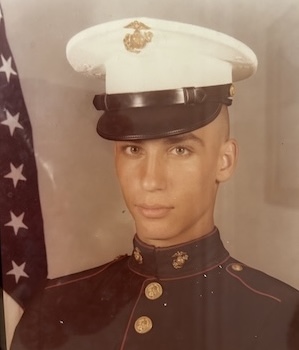Russell Bohn was feeling it. Climbing stairs at his job at the Veterans Administration hospital in Houston left him winded. Sometimes his shortness of breath was accompanied by a tightness in his chest. The 63-year-old former Marine thought he was having a lung issue, so during a six-month wellness check, he explained his symptoms to his doctor.
The physician made a series of checks, including performing an electrocardiogram, or EKG. He looked at the squiggly lines on the paper that represented the electrical activity of Bohn’s heart and didn’t like what he saw. He sent Bohn to the emergency room.
Once at St. Luke's Health-The Woodlands, Bohn underwent a cardiac catheterization procedure so a specialist could see the internal workings of his heart. The cardiologist found a small right coronary artery 80% blocked, but most concerning was the fully blocked left anterior descending (LAD) artery, which carries nearly half the blood to the heart. Bohn didn’t have a full-fledged heart attack because his other arteries had created new channels, known as collateral vessels, to keep blood flowing.
Bohn met with the surgeon to discuss next steps. Dr. Vivek Patel, assistant professor of surgery in the Division of Cardiothoracic Surgery at Baylor College of Medicine, told Bohn he was a great candidate for robotic-assisted coronary bypass surgery. The blockage in the smaller coronary artery could wait and would be stented a few weeks later.
“He explained the procedure, how they use the robot and the cameras and the little mini tools, and how, once everything's in place, they put a slit in your chest, and he sews the new artery on past the blockage, bypassing the blockage in my LAD artery,” said Bohn, who remained in the hospital for several days until his surgery, which took place in early March.
During the operation, Dr. Patel made three small keyhole incisions on the left chest, used an internal mammary artery for the bypass and did not have to use the heart-lung machine.
“When we do it this way, we do the bypass with the heart beating, so there's less risk of transfusions, less risk of stroke and faster recovery and less pain,” Dr. Patel said.
“Everything went great,” Dr. Patel said. “He did very well. Had minimal pain afterward and flew right out of here.”
Said Bohn: “I was up walking the same day, I continued walking the next two days and was discharged.”
Bohn participated in cardiac rehab and was ready to get back on the job at the VA hospital, where he is a senior IT specialist.
Bohn spent 22 years in the Marine Corps after enlisting in 1979. He was stationed around the world, including India and Finland, where he guarded the U.S. embassies. He also served in Korea and Japan and was stationed in Hawaii and on both U.S. coasts.
“I had every boy’s dream,” he said, describing stints as a firefighter, police officer and recruiter. He retired in 2001 as a gunnery sergeant, where he was a senior staff non-commissioned officer leading the troops.
Bohn, who had some high blood pressure and high cholesterol but was otherwise fairly healthy, knew heart disease ran in his family. His grandfather died at age 65, when, after celebrating his retirement, he went to sleep and never woke up. Bohn’s father had open-heart surgery in the ‘90s because of coronary artery disease. He contracted a staph infection and was hospitalized for three months. Bohn wanted to avoid a similar fate.
“I thought, well, I exercise, I eat decent, so I'm probably going to be fine,” Bohn said. “I've never had a heart attack, but I was certainly primed for one.”
The resident of Spring, Texas, is currently taking several medications, but has no physical restrictions. He knows to follow a heart-healthy diet, watch his sodium intake and continue to exercise.
His advice to others is to communicate with your primary care doctor and tell them what's going on.
“You know, as smart as I am, and this is going to sound conceited, but as smart as I am, I was dumb enough to think it was my lungs and not my heart.”
